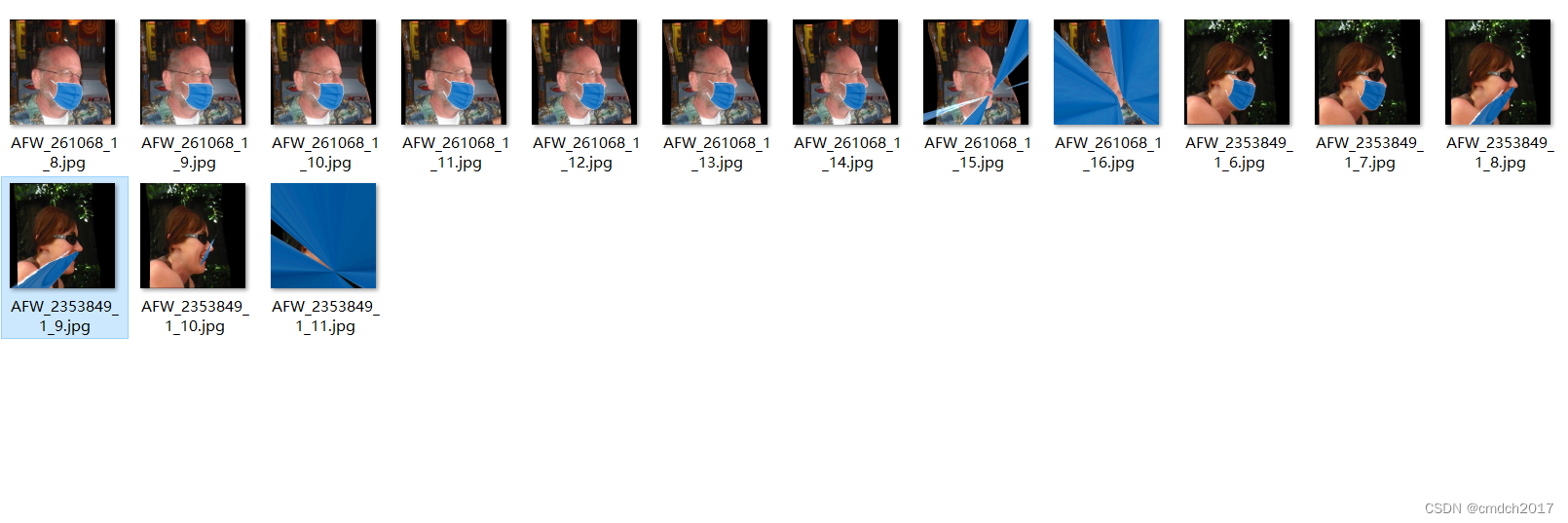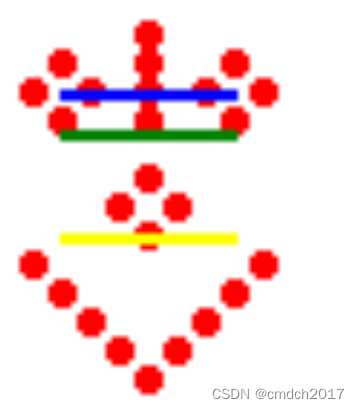官网下载mask the face 代码,增加代码draw_face.py

import argparse
import cv2
import scipy.io
from tqdm import tqdm
from utils.aux_functions_2 import *# 设置命令行输入参数
parser = argparse.ArgumentParser(description="MaskTheFace - Python code to mask faces dataset"
)# 图像路径参数,可以是文件夹或单个图像
parser.add_argument("--path",type=str,default="D:\MaskTheFace-master\\test",help="Path to either the folder containing images or the image itself",
)# 口罩类型参数
parser.add_argument("--mask_type",type=str,default="surgical_blue",choices=["surgical", "N95", "KN95", "cloth", "gas", "inpaint", "random", "all"],help="Type of the mask to be applied. Available options: all, surgical, N95, cloth",
)# 口罩图案参数
parser.add_argument("--pattern",type=str,default="",help="Type of the pattern. Available options in masks/textures",
)# 图案权重参数
parser.add_argument("--pattern_weight",type=float,default=0.5,help="Weight of the pattern. Must be between 0 and 1",
)# 口罩颜色参数
parser.add_argument("--color",type=str,default="#0473e2",help="Hex color value that need to be overlayed to the mask",
)# 颜色权重参数
parser.add_argument("--color_weight",type=float,default=0.5,help="Weight of the color intensity. Must be between 0 and 1",
)# 生成特定格式的口罩代码参数
parser.add_argument("--code",type=str,default="",help="Generate specific formats",
)# 是否开启详细模式参数
parser.add_argument("--verbose", dest="verbose", action="store_true", help="Turn verbosity on"
)# 是否保存原始图像参数
parser.add_argument("--write_original_image",dest="write_original_image",action="store_true",help="If true, original image is also stored in the masked folder",
)# 设置默认参数
parser.set_defaults(feature=False)# 解析参数
args = parser.parse_args()
args.write_path = args.path + "_masked2"# 检查路径是文件夹、文件还是其他
is_directory, is_file, is_other = check_path(args.path)def process_image(image_path, args, write_path):if image_path.__contains__("_pts.mat"):return# 获取对应的 .mat 文件路径mat_path = os.path.splitext(image_path)[0] + '_pts.mat'if not os.path.exists(mat_path):print(f"MAT file for {image_path} not found.")returnif is_image(image_path):print("image_path:"+image_path)# 如果是图像文件,处理图像if args.verbose:str_p = "Processing: " + image_pathtqdm.write(str_p)# 加载 MATLAB 文件mat = scipy.io.loadmat(mat_path)# 获取关键点landmarks = mat['pts_2d']masked_image, mask, mask_binary_array, original_image = mask_image(image_path, args, landmarks)for i in range(len(mask)):split_path = os.path.splitext(image_path)w_path = os.path.join(write_path, os.path.basename(split_path[0]) + split_path[1])img = masked_image[i]cv2.imwrite(w_path, img)if args.write_original_image:w_path_original = os.path.join(write_path, "original_" + os.path.basename(image_path))cv2.imwrite(w_path_original, original_image)if is_directory:# 如果是文件夹,获取其中的文件和子文件夹path, dirs, files = next(os.walk(args.path))file_count = len(files)dirs_count = len(dirs)if len(files) > 0:print_orderly("Masking image files", 60)# 处理文件夹中的每个文件for f in tqdm(files):image_path = os.path.join(path, f)write_path = args.write_pathif not os.path.isdir(write_path):os.makedirs(write_path)process_image(image_path, args, write_path)print_orderly("Masking image directories", 60)# 处理文件夹中的每个子文件夹for d in tqdm(dirs):dir_path = os.path.join(args.path, d)dir_write_path = os.path.join(args.write_path, d)if not os.path.isdir(dir_write_path):os.makedirs(dir_write_path)_, _, files = next(os.walk(dir_path))# 处理子文件夹中的每个文件for f in files:image_path = os.path.join(dir_path, f)process_image(image_path, args, dir_write_path)elif is_file:print("Masking image file")image_path = args.pathwrite_path = args.write_pathif not os.path.isdir(write_path):os.makedirs(write_path)process_image(image_path, args, write_path)
else:print("Path is neither a valid file or a valid directory")print("Processing Done")aux_functions_2.py
计算鼻中线:
从鼻子桥的起点到鼻尖,确定鼻子的垂直方向。
计算嘴唇底线:
获取嘴唇底部的左右嘴角中点,计算它们之间的中线。
计算垂直线:
从鼻子桥的起点垂直于眼睛中线,确定面部的垂直对称线。
获取下巴上的点:
使用鼻中线和嘴唇底线在下巴上找到相交点。
这些点用于确定口罩在面部的下部位置。
根据这些线和点确定口罩的六个关键点:
这些点分别是:面部的上部、中部、下部和两侧的位置。
使用这些点来变形和调整口罩的形状。
代码逻辑说明
get_line函数:
输入:面部关键点(face_landmark),图像(image),类型(type)。
输出:眼睛中线,垂直线,左右点,中点。
get_points_on_chin函数:
输入:线(line),面部关键点(face_landmark)。
输出:在下巴上与输入线相交的点。
get_six_points函数:
输入:面部关键点(face_landmark),图像(image)。
输出:面部的六个关键点,角度(angle)。
mask_face函数:
输入:图像(image),六个关键点(six_points),角度(angle),参数(args),类型(type)。
输出:带有口罩的图像,口罩的二值掩码。
通过以上步骤和角度的计算,可以在面部图像上精确地绘制口罩,使其与面部特征完美贴合。
import bz2
import random
import shutil
from configparser import ConfigParserimport cv2
import math
import os
import requests
from PIL import Image, ImageDraw
from imutils import face_utilsfrom utils.create_mask import texture_the_mask, color_the_mask
from utils.fit_ellipse import *
from utils.read_cfg import read_cfgdef get_line(face_landmark, image, type="eye", debug=False):pil_image = Image.fromarray(image)d = ImageDraw.Draw(pil_image)left_eye = face_landmark["left_eye"]right_eye = face_landmark["right_eye"]left_eye_mid = np.mean(np.array(left_eye), axis=0)right_eye_mid = np.mean(np.array(right_eye), axis=0)eye_line_mid = (left_eye_mid + right_eye_mid) / 2if type == "eye":left_point = left_eye_midright_point = right_eye_midmid_point = eye_line_midelif type == "nose_mid":nose_length = (face_landmark["nose_bridge"][-1][1] - face_landmark["nose_bridge"][0][1])left_point = [left_eye_mid[0], left_eye_mid[1] + nose_length / 2]right_point = [right_eye_mid[0], right_eye_mid[1] + nose_length / 2]# mid_point = (# face_landmark["nose_bridge"][-1][1] + face_landmark["nose_bridge"][0][1]# ) / 2mid_pointY = (face_landmark["nose_bridge"][-1][1] + face_landmark["nose_bridge"][0][1]) / 2mid_pointX = (face_landmark["nose_bridge"][-1][0] + face_landmark["nose_bridge"][0][0]) / 2mid_point = (mid_pointX, mid_pointY)elif type == "nose_tip":nose_length = (face_landmark["nose_bridge"][-1][1] - face_landmark["nose_bridge"][0][1])left_point = [left_eye_mid[0], left_eye_mid[1] + nose_length]right_point = [right_eye_mid[0], right_eye_mid[1] + nose_length]mid_point = (face_landmark["nose_bridge"][-1][1] + face_landmark["nose_bridge"][0][1]) / 2elif type == "bottom_lip":bottom_lip = face_landmark["bottom_lip"]bottom_lip_mid = np.max(np.array(bottom_lip), axis=0)shiftY = bottom_lip_mid[1] - eye_line_mid[1]left_point = [left_eye_mid[0], left_eye_mid[1] + shiftY]right_point = [right_eye_mid[0], right_eye_mid[1] + shiftY]mid_point = bottom_lip_midelif type == "perp_line":bottom_lip = face_landmark["bottom_lip"]bottom_lip_mid = np.mean(np.array(bottom_lip), axis=0)left_point = eye_line_midleft_point = face_landmark["nose_bridge"][0]right_point = bottom_lip_midmid_point = bottom_lip_midelif type == "nose_long":nose_bridge = face_landmark["nose_bridge"]left_point = [nose_bridge[0][0], nose_bridge[0][1]]right_point = [nose_bridge[-1][0], nose_bridge[-1][1]]mid_point = left_point# d.line(eye_mid, width=5, fill='red')y = [left_point[1], right_point[1]]x = [left_point[0], right_point[0]]# cv2.imshow('h', image)# cv2.waitKey(0)eye_line = fit_line(x, y, image)d.line(eye_line, width=5, fill="blue")# Perpendicular Line# (midX, midY) and (midX - y2 + y1, midY + x2 - x1)y = [(left_point[1] + right_point[1]) / 2,(left_point[1] + right_point[1]) / 2 + right_point[0] - left_point[0],]x = [(left_point[0] + right_point[0]) / 2,(left_point[0] + right_point[0]) / 2 - right_point[1] + left_point[1],]perp_line = fit_line(x, y, image)if debug:d.line(perp_line, width=5, fill="red")pil_image.show()return eye_line, perp_line, left_point, right_point, mid_pointdef get_points_on_chin(line, face_landmark, chin_type="chin"):chin = face_landmark[chin_type]points_on_chin = []for i in range(len(chin) - 1):chin_first_point = [chin[i][0], chin[i][1]]chin_second_point = [chin[i + 1][0], chin[i + 1][1]]flag, x, y = line_intersection(line, (chin_first_point, chin_second_point))if flag:points_on_chin.append((x, y))return points_on_chindef plot_lines(face_line, image, debug=False):pil_image = Image.fromarray(image)if debug:d = ImageDraw.Draw(pil_image)d.line(face_line, width=4, fill="white")pil_image.show()def line_intersection(line1, line2):# mid = int(len(line1) / 2)start = 0end = -1line1 = ([line1[start][0], line1[start][1]], [line1[end][0], line1[end][1]])xdiff = (line1[0][0] - line1[1][0], line2[0][0] - line2[1][0])ydiff = (line1[0][1] - line1[1][1], line2[0][1] - line2[1][1])x = []y = []flag = Falsedef det(a, b):return a[0] * b[1] - a[1] * b[0]div = det(xdiff, ydiff)if div == 0:return flag, x, yd = (det(*line1), det(*line2))x = det(d, xdiff) / divy = det(d, ydiff) / divsegment_minX = min(line2[0][0], line2[1][0])segment_maxX = max(line2[0][0], line2[1][0])segment_minY = min(line2[0][1], line2[1][1])segment_maxY = max(line2[0][1], line2[1][1])if (segment_maxX + 1 >= x >= segment_minX - 1and segment_maxY + 1 >= y >= segment_minY - 1):flag = Truereturn flag, x, ydef fit_line(x, y, image):if x[0] == x[1]:x[0] += 0.1coefficients = np.polyfit(x, y, 1)polynomial = np.poly1d(coefficients)x_axis = np.linspace(0, image.shape[1], 50)y_axis = polynomial(x_axis)eye_line = []for i in range(len(x_axis)):eye_line.append((x_axis[i], y_axis[i]))return eye_linedef get_six_points(face_landmark, image):_, perp_line1, _, _, m = get_line(face_landmark, image, type="nose_mid")face_b = mperp_line, _, _, _, _ = get_line(face_landmark, image, type="perp_line")points1 = get_points_on_chin(perp_line1, face_landmark)points = get_points_on_chin(perp_line, face_landmark)if not points1:face_e = tuple(np.asarray(points[0]))elif not points:face_e = tuple(np.asarray(points1[0]))else:face_e = tuple((np.asarray(points[0]) + np.asarray(points1[0])) / 2)nose_mid_line, _, _, _, _ = get_line(face_landmark, image, type="nose_long")angle = get_angle(perp_line, nose_mid_line)# print("angle: ", angle)nose_mid_line, _, _, _, _ = get_line(face_landmark, image, type="nose_tip")points = get_points_on_chin(nose_mid_line, face_landmark)if len(points) < 2:face_landmark = get_face_ellipse(face_landmark)points = get_points_on_chin(nose_mid_line, face_landmark, chin_type="chin_extrapolated")if len(points) < 2:points = []points.append(face_landmark["chin"][0])points.append(face_landmark["chin"][-1])face_a = points[0]face_c = points[-1]nose_mid_line, _, _, _, _ = get_line(face_landmark, image, type="bottom_lip")points = get_points_on_chin(nose_mid_line, face_landmark)face_d = points[0]face_f = points[-1]six_points = np.float32([face_a, face_b, face_c, face_f, face_e, face_d])return six_points, angledef get_angle(line1, line2):delta_y = line1[-1][1] - line1[0][1]delta_x = line1[-1][0] - line1[0][0]perp_angle = math.degrees(math.atan2(delta_y, delta_x))if delta_x < 0:perp_angle = perp_angle + 180if perp_angle < 0:perp_angle += 360if perp_angle > 180:perp_angle -= 180delta_y = line2[-1][1] - line2[0][1]delta_x = line2[-1][0] - line2[0][0]nose_angle = math.degrees(math.atan2(delta_y, delta_x))if delta_x < 0:nose_angle = nose_angle + 180if nose_angle < 0:nose_angle += 360if nose_angle > 180:nose_angle -= 180angle = nose_angle - perp_anglereturn angledef mask_face(image, six_points, angle, args, type="surgical"):debug = False# Find the face anglethreshold = 13if angle < -threshold:type += "_right"elif angle > threshold:type += "_left"w = image.shape[0]h = image.shape[1]if not "empty" in type and not "inpaint" in type:cfg = read_cfg(config_filename="masks/masks.cfg", mask_type=type, verbose=False)else:if "left" in type:str = "surgical_blue_left"elif "right" in type:str = "surgical_blue_right"else:str = "surgical_blue"cfg = read_cfg(config_filename="masks/masks.cfg", mask_type=str, verbose=False)img = cv2.imread(cfg.template, cv2.IMREAD_UNCHANGED)# Process the mask if necessaryif args.pattern:# Apply pattern to maskimg = texture_the_mask(img, args.pattern, args.pattern_weight)if args.color:# Apply color to maskimg = color_the_mask(img, args.color, args.color_weight)mask_line = np.float32([cfg.mask_a, cfg.mask_b, cfg.mask_c, cfg.mask_f, cfg.mask_e, cfg.mask_d])# Warp the maskM, mask = cv2.findHomography(mask_line, six_points)dst_mask = cv2.warpPerspective(img, M, (h, w))dst_mask_points = cv2.perspectiveTransform(mask_line.reshape(-1, 1, 2), M)mask = dst_mask[:, :, 3]image_face = image# Adjust Brightnessmask_brightness = get_avg_brightness(img)img_brightness = get_avg_brightness(image_face)delta_b = 1 + (img_brightness - mask_brightness) / 255dst_mask = change_brightness(dst_mask, delta_b)# Adjust Saturationmask_saturation = get_avg_saturation(img)img_saturation = get_avg_saturation(image_face)delta_s = 1 - (img_saturation - mask_saturation) / 255dst_mask = change_saturation(dst_mask, delta_s)# Apply maskmask_inv = cv2.bitwise_not(mask)img_bg = cv2.bitwise_and(image, image, mask=mask_inv)img_fg = cv2.bitwise_and(dst_mask, dst_mask, mask=mask)out_img = cv2.add(img_bg, img_fg[:, :, 0:3])if "empty" in type or "inpaint" in type:out_img = img_bg# Plot key pointsif "inpaint" in type:out_img = cv2.inpaint(out_img, mask, 3, cv2.INPAINT_TELEA)if debug:for i in six_points:cv2.circle(out_img, (i[0], i[1]), radius=4, color=(0, 0, 255), thickness=-1)for i in dst_mask_points:cv2.circle(out_img, (i[0][0], i[0][1]), radius=4, color=(0, 255, 0), thickness=-1)return out_img, maskdef draw_landmarks(face_landmarks, image):pil_image = Image.fromarray(image)d = ImageDraw.Draw(pil_image)for facial_feature in face_landmarks.keys():d.line(face_landmarks[facial_feature], width=5, fill="white")pil_image.show()def get_face_ellipse(face_landmark):chin = face_landmark["chin"]x = []y = []for point in chin:x.append(point[0])y.append(point[1])x = np.asarray(x)y = np.asarray(y)a = fitEllipse(x, y)center = ellipse_center(a)phi = ellipse_angle_of_rotation(a)axes = ellipse_axis_length(a)a, b = axesarc = 2.2R = np.arange(0, arc * np.pi, 0.2)xx = center[0] + a * np.cos(R) * np.cos(phi) - b * np.sin(R) * np.sin(phi)yy = center[1] + a * np.cos(R) * np.sin(phi) + b * np.sin(R) * np.cos(phi)chin_extrapolated = []for i in range(len(R)):chin_extrapolated.append((xx[i], yy[i]))face_landmark["chin_extrapolated"] = chin_extrapolatedreturn face_landmarkdef get_avg_brightness(img):img_hsv = cv2.cvtColor(img, cv2.COLOR_BGR2HSV)h, s, v = cv2.split(img_hsv)return np.mean(v)def get_avg_saturation(img):img_hsv = cv2.cvtColor(img, cv2.COLOR_BGR2HSV)h, s, v = cv2.split(img_hsv)return np.mean(v)def change_brightness(img, value=1.0):img_hsv = cv2.cvtColor(img, cv2.COLOR_BGR2HSV)h, s, v = cv2.split(img_hsv)v = value * vv[v > 255] = 255v = np.asarray(v, dtype=np.uint8)final_hsv = cv2.merge((h, s, v))img = cv2.cvtColor(final_hsv, cv2.COLOR_HSV2BGR)return imgdef change_saturation(img, value=1.0):img_hsv = cv2.cvtColor(img, cv2.COLOR_BGR2HSV)h, s, v = cv2.split(img_hsv)s = value * ss[s > 255] = 255s = np.asarray(s, dtype=np.uint8)final_hsv = cv2.merge((h, s, v))img = cv2.cvtColor(final_hsv, cv2.COLOR_HSV2BGR)return imgdef check_path(path):is_directory = Falseis_file = Falseis_other = Falseif os.path.isdir(path):is_directory = Trueelif os.path.isfile(path):is_file = Trueelse:is_other = Truereturn is_directory, is_file, is_otherdef shape_to_landmarks(shape):face_landmarks = {}face_landmarks["left_eyebrow"] = [tuple(shape[17]),tuple(shape[18]),tuple(shape[19]),tuple(shape[20]),tuple(shape[21]),]face_landmarks["right_eyebrow"] = [tuple(shape[22]),tuple(shape[23]),tuple(shape[24]),tuple(shape[25]),tuple(shape[26]),]face_landmarks["nose_bridge"] = [tuple(shape[27]),tuple(shape[28]),tuple(shape[29]),tuple(shape[30]),]face_landmarks["nose_tip"] = [tuple(shape[31]),tuple(shape[32]),tuple(shape[33]),tuple(shape[34]),tuple(shape[35]),]face_landmarks["left_eye"] = [tuple(shape[36]),tuple(shape[37]),tuple(shape[38]),tuple(shape[39]),tuple(shape[40]),tuple(shape[41]),]face_landmarks["right_eye"] = [tuple(shape[42]),tuple(shape[43]),tuple(shape[44]),tuple(shape[45]),tuple(shape[46]),tuple(shape[47]),]face_landmarks["top_lip"] = [tuple(shape[48]),tuple(shape[49]),tuple(shape[50]),tuple(shape[51]),tuple(shape[52]),tuple(shape[53]),tuple(shape[54]),tuple(shape[60]),tuple(shape[61]),tuple(shape[62]),tuple(shape[63]),tuple(shape[64]),]face_landmarks["bottom_lip"] = [tuple(shape[54]),tuple(shape[55]),tuple(shape[56]),tuple(shape[57]),tuple(shape[58]),tuple(shape[59]),tuple(shape[48]),tuple(shape[64]),tuple(shape[65]),tuple(shape[66]),tuple(shape[67]),tuple(shape[60]),]face_landmarks["chin"] = [tuple(shape[0]),tuple(shape[1]),tuple(shape[2]),tuple(shape[3]),tuple(shape[4]),tuple(shape[5]),tuple(shape[6]),tuple(shape[7]),tuple(shape[8]),tuple(shape[9]),tuple(shape[10]),tuple(shape[11]),tuple(shape[12]),tuple(shape[13]),tuple(shape[14]),tuple(shape[15]),tuple(shape[16]),]return face_landmarksdef mask_image(image_path, args, shape):# Read the imageimage = cv2.imread(image_path)original_image = image.copy()gray = image# face_locations = args.detector(gray, 1)mask_type = args.mask_typeif args.code:ind = random.randint(0, len(args.code_count) - 1)mask_dict = args.mask_dict_of_dict[ind]mask_type = mask_dict["type"]args.color = mask_dict["color"]args.pattern = mask_dict["texture"]args.code_count[ind] += 1elif mask_type == "random":available_mask_types = get_available_mask_types()mask_type = random.choice(available_mask_types)# Process each face in the imagemasked_images = []mask_binary_array = []# mask = []# for (i, face_location) in enumerate(face_locations):face_landmarks = shape_to_landmarks(shape)six_points_on_face, angle = get_six_points(face_landmarks, image)mask = []if mask_type != "all":if len(masked_images) > 0:image = masked_images.pop(0)image, mask_binary = mask_face(image, six_points_on_face, angle, args, type=mask_type)# compress to face tightmasked_images.append(image)mask_binary_array.append(mask_binary)mask.append(mask_type)else:available_mask_types = get_available_mask_types()for m in range(len(available_mask_types)):if len(masked_images) == len(available_mask_types):image = masked_images.pop(m)img, mask_binary = mask_face(image,six_points_on_face,angle,args,type=available_mask_types[m],)masked_images.insert(m, img)mask_binary_array.insert(m, mask_binary)mask = available_mask_typesreturn masked_images, mask, mask_binary_array, original_imagedef is_image(path):try:extensions = path[-4:]image_extensions = ["png", "PNG", "jpg", "JPG"]if extensions[1:] in image_extensions:return Trueelse:print("Please input image file. png / jpg")return Falseexcept:return Falsedef get_available_mask_types(config_filename="masks/masks.cfg"):parser = ConfigParser()parser.optionxform = strparser.read(config_filename)available_mask_types = parser.sections()available_mask_types = [string for string in available_mask_types if "left" not in string]available_mask_types = [string for string in available_mask_types if "right" not in string]return available_mask_typesdef print_orderly(str, n):# print("")hyphens = "-" * int((n - len(str)) / 2)str_p = hyphens + " " + str + " " + hyphenshyphens_bar = "-" * len(str_p)print(hyphens_bar)print(str_p)print(hyphens_bar)def display_MaskTheFace():with open("utils/display.txt", "r") as file:for line in file:print(line, end="")
演示代码逻辑

import cv2
import numpy as np
from PIL import Image, ImageDrawdef plot_landmarks_and_lines(image, landmarks):pil_image = Image.fromarray(image)draw = ImageDraw.Draw(pil_image)# 绘制关键点for part, points in landmarks.items():for point in points:draw.ellipse((point[0] - 2, point[1] - 2, point[0] + 2, point[1] + 2), fill='red')# 绘制眼睛线条left_eye = np.mean(np.array(landmarks['left_eye']), axis=0)right_eye = np.mean(np.array(landmarks['right_eye']), axis=0)draw.line((tuple(left_eye), tuple(right_eye)), fill='blue', width=2)# 绘制鼻子中线nose_bridge = landmarks['nose_bridge']nose_length = nose_bridge[-1][1] - nose_bridge[0][1]left_point = [left_eye[0], left_eye[1] + nose_length / 2]right_point = [right_eye[0], right_eye[1] + nose_length / 2]draw.line((tuple(left_point), tuple(right_point)), fill='green', width=2)# 绘制下唇线bottom_lip = np.max(np.array(landmarks['bottom_lip']), axis=0)shiftY = bottom_lip[1] - (left_eye[1] + right_eye[1]) / 2left_point = [left_eye[0], left_eye[1] + shiftY]right_point = [right_eye[0], right_eye[1] + shiftY]draw.line((tuple(left_point), tuple(right_point)), fill='yellow', width=2)# 显示图像pil_image.show()# 示例人脸关键点
landmarks = {'left_eye': [(30, 50), (35, 45), (40, 50), (35, 55)],'right_eye': [(60, 50), (65, 45), (70, 50), (65, 55)],'nose_bridge': [(50, 40), (50, 45), (50, 50), (50, 55)],'bottom_lip': [(45, 70), (50, 75), (55, 70), (50, 65)],'chin': [(30, 80), (35, 85), (40, 90), (45, 95), (50, 100), (55, 95), (60, 90), (65, 85), (70, 80)]
}# 加载示例图像(请替换为实际图像路径)
image = np.ones((120, 100, 3), dtype=np.uint8) * 255# 绘制关键点和线条
plot_landmarks_and_lines(image, landmarks))


)


![[实践篇]13.29 再来聊下Pass Through设备透传](http://pic.xiahunao.cn/[实践篇]13.29 再来聊下Pass Through设备透传)
架构类型)
)









——系统模型和基于子空间的延时估计)
